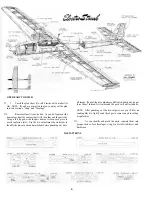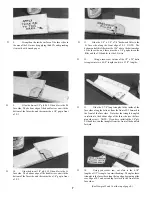
3. You must use a proper R/C radio that is in first class
condition, the correct size motor and correct components
(wheels, etc) throughout your building process.
4 You must properly install all R/C and other compo-
nents so that the model operates properly on the ground.
5 You must test the operation of the model before the
first and each successive flight to insure that all equipment is
operating and you must make certain that the model has remained
structurally sound.
6. You must fly the model only with competent help
from a well experienced R/C pilot if you are not already an
experienced and knowledgeable R/C pilot at this time.
Note: We, as the kit manufacturer, can provide you with
a top quality kit and great instructions, but ultimately the quality
and flyability of your finished model depends on how you build
it, therefore, we cannot in any way guarantee the performance of
your completed model, and no representations are expressed or
implied as to the performance or safety of your completed model
Remember: Take your time and follow directions to
end up with a well-built model that is straight and true.
KEEP IT LIGHT!
Because the electric motor and motor battery are rela-
tively heavy, and because electric motors do not produce as much
thrust as glow engines (when compared to their weight), it is
essential that the basic structure of the airplane be kept as light
as possible In doing so, you will help insure that the finished
airplane will not be too heavy to fly well.
One way to prevent excess weight build-up is to use
only as much glue as needed for good glue joints Do not apply
extra "fillets" of glue thinking that it will make your plane
stronger' All that extra glue adds ounces to the weight of your
plane, and will detract from the performance.
In order to help you build a light airplane, many parts
in this kit are made from soft balsa Because the wood is soft, it
does not die cut cleanly and it dents easily Therefore, you will
have to do a little more sanding on the edges of the die cut parts
before using them, and you may have to fill a few more dents and
"dings". The soft balsa is also more fragile, so use a little extra care
to avoid damaging the parts.
We will give you tips throughout this book on how to
keep the structure light, and we urge you to follow them.
RADIO SELECTION
Because the ElectroStreak is optimized for light weight,
you must use a radio system with "micro" servos and a 225 mAh
flight pack battery Our prototype uses a Futaba radio with three
S33 servos and a Robart HQ500 electronic speed control The
radio equipment you choose must be small and lightweight.
SPEED CONTROL SELECTION
You must equip your ElectroStreak with some type of
motor control to enable you to turn the motor on and off with the
transmitter The best way to accomplish this is by installing an
electronic speed control, which provides fully proportional
control of the motor speed You should choose a speed control
that is capable of handling at least 25 Amps of continuous current.
It is not necessary to have fully proportional speed
control in this airplane Instead, you may prefer the simplicity
(and cost savings) of a simple on-off switch, activated by a 4th
micro servo To accomplish this you may purchase a micro
switch or toggle switch (from an electronics supply store, such as
Radio Shack) and mount it to the "throttle" servo using double-
stick tape.
NOTE: Many electronic speed controls have a built-in safety
feature which acts like a circuit breaker in case of an overload due
to a short circuit or a stalled propeller, however, if you are using
a simple switch system, you should install a 20 or 25 amp fuse in
your switch harness to protect the electrical components and to
prevent fire or explosion in the event of an overload
BATTERY SELECTION
In order to give the ElectroStreak sufficient power to
perform large acrobatic maneuvers, we strongly recommend that
you use a good quality 7 cell nicad battery pack for motor power.
The individual cells in the battery pack should be "low imped-
ance", which means that they are capable of delivering high
current to the motor (Sanyo SCR cells, for example)
If you choose a 7-cell 1200 mAh battery pack, it should
be a "flat" pack, such as the "Kyosho Turbo Racing Battery"
You can cut several ounces from the flying weight of
your ElectroStreak, thereby improving performance, by using a
7 cell 800 mAh battery pack The major disadvantage is that
flight times will be reduced to only 2 or 2-1/2 minutes (continu-
ous motor run).
BATTERY CHARGER SELECTION
You may use any of the commercially available battery
chargers that are designed for charging 7 cell nicad battery packs.
Some chargers have a "peak detector" which sense when the
battery is fully charged and automatically shut off at the right
time Some chargers operate from 110 volt house current, 12 volt
DC (automobile battery), 01 both For convenience, we recom-
mend a "fast charger" that will charge a 7-cell 1200 mAh battery
pack m approximately 20 minutes.
PROPELLER SELECTION
We tested several different propellers on the Electro-
Streak, and found the G rish Tornado 7x6 nylon prop to be a very
good all around choice An 8x4 prop provides a little more thrust
on takeoff, but the 7x6 gives more speed and better overall
performance Wood props break very often when this airplane is
"belly landed", so they are not recommended unless you are using
the landing gear.
3


















